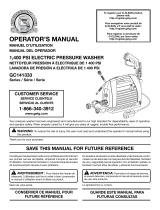
Use caution when positioning the pressure washer
for use. Warm air from the motor could cause discolored
spots on grass.
Know your product. Read the operator’s manual care-
fully. Learn the machine’s applications and limitations
as well as the specific potential hazards related to this
product.
To reduce the risk of injury, keep children and visitors
away. All visitors should wear safety glasses and be kept
a safe distance from work area.
Use right product. Don’t force product or attachment to
do a job it was not designed for. Don’t use it for a purpose
not intended.
Dress properly. Wear long pants and long sleeves. Do
not wear loose clothing, gloves, neckties, or jewelry. They
can get caught and draw you into moving parts. Rubber
gloves and nonskid footwear are recommended when
working outdoors. Also wear protective hair covering to
contain long hair.
Do not operate the equipment while barefoot or when
wearing sandals or similar lightweight footwear. Wear
protective footwear that will protect your feet and improve
your footing on slippery surfaces.
Exercise caution to avoid slipping or falling.
Always wear eye protection with side shields marked
to comply with ANSI Z87.1. Following this rule will re-
duce the risk of serious personal injury.
Use only recommended accessories. The use of im-
proper accessories may cause risk of injury.
Check damaged parts. Before further use of the product,
a guard or other part that is damaged should be care-
fully checked to determine that it will operate properly
and perform its intended function. Check for alignment
of moving parts, binding of moving parts, breakage of
parts, mounting, and any other conditions that may af-
fect its operation. A guard or other part that is damaged
must be properly repaired or replaced by an authorized
service center to avoid risk of personal injury.
Never leave product running unattended. Turn power
off. Don’t leave product until it comes to a complete stop.
Keep the motor free of grass, leaves, or grease to
reduce the chance of a fire hazard.
Follow manufacturer’s recommendations for safe
loading, unloading, transport, and storage of machine.
Keep product dry, clean, and free from oil and grease.
Always use a clean cloth when cleaning. Never use brake
fluids, gasoline, petroleum-based products, or any sol-
vents to clean product.
Check the work area before each use. Remove all
objects such as rocks, broken glass, nails, wire, or string
which can be thrown or become entangled in the
machine.
Do not use product if switch does not turn it off. Have
defective switches replaced by an authorized service
center.
Avoid dangerous environment. Don’t expose to rain.
Keep work area well lit.
Do not abuse the cord. Never use the cord to carry the
product or to disconnect the plug from an outlet. Keep
cord away from heat, oil, sharp edges, or moving parts.
Replace damaged cords immediately. Damaged cords
increase the risk of electric shock.
Ground Fault Circuit Interrupter (GFCI) protection
should be provided on the circuit(s) or outlet(s) to be
used for the product. Receptacles are available having
built-in GFCI protection and may be used for this measure
of safety.
To reduce the risk of electric shock, this product has
a polarized plug (one blade is wider than the other)
and will require the use of a polarized extension cord.
The plug will fit into a polarized extension cord only one
way. If the plug does not fit fully into the extension cord,
reverse the plug. If the plug still does not fit, obtain a
correct polarized extension cord. A polarized extension
cord will require the use of a polarized wall outlet. This
plug will fit into the polarized wall outlet only one way.
If the plug does not fit fully into the wall outlet, reverse
the plug. If the plug still does not fit, contact a qualified
electrician to install the proper wall outlet. Do not change
the equipment plug, extension cord receptacle, or exten-
sion cord plug in any way.
This pressure washer is not recommended for use
with an extension cord. If an extension cord must be
used, please make sure it is in good condition. When
using an extension cord, be sure to use one heavy enough
to carry the current your product will draw. A wire gauge
size (A.W.G.) of at least 12 is recommended for an ex-
tension cord 25 feet or less in length. If in doubt, use the
next heavier gauge. The smaller the gauge number, the
heavier the cord. An undersized cord will cause a drop in
line voltage resulting in loss of power and overheating.
WARNING: Use outdoor extension cords marked SW-A,
SOW-A, STW-A, STOW-A, SJW-A, SJTW-A, or SJTOWA.
These cords are rated for outdoor use and reduce the risk
of electric shock.
Inspect extension cords periodically and replace if
damaged. Keep handles dry, clean, and free from oil or
grease.
Never direct a water stream toward people or pets,
or any electrical device.
Before starting any cleaning operation, close doors
and windows. Clear the area to be cleaned of debris,
toys, outdoor furniture, or other objects that could create
a hazard.




















